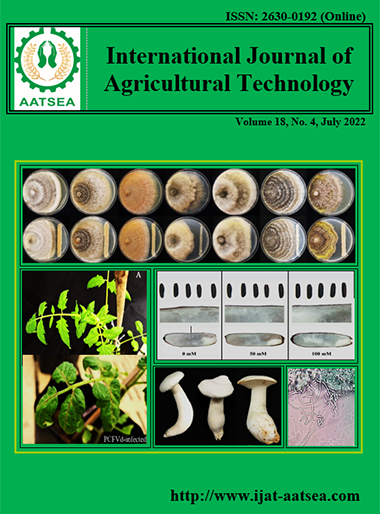Phytochemical characteristics of white turmeric rhizome (Curcuma zedoaria (Berg.) Roscoe) essential oil from Lembang, West Java, Indonesia
Main Article Content
Abstract
White turmeric (Curcuma zedoaria) rhizome is widely used as a cooking and medicinal ingredient. It is important to determine the essential oil standard that is abundant in white turmeric to prevent adulteration. The results showed that the yield concentration of essential oil from C. zedoaria was 0.66% v/w with the following characteristics: brownies colour, spicy taste, as well as sharp and specific aroma. The phytochemical screening result indicated that the essential oil contained alkaloid, flavonoid, triterpenoid, sesquiterpenoid, and quinone. Other phytochemical characteristics included specific gravity value, optical rotation, refractive index, and sapofinication value which were 0.989 g/cm3, (+)15.19, 1.501, and 28.05 respectively. C.zedoaria essential oil was soluble in 80% and 90% ethanol but not soluble in 50%, 60%, and 70% ethanol. Using GC-MS, twenty-one compounds were identified in the essential oil, of which camphor was the marker compound
Article Details

This work is licensed under a Creative Commons Attribution-NonCommercial-NoDerivatives 4.0 International License.
References
Alam, P. N., Husin, H., Asnawi, T. M. and Adisalamun. (2018). Extraction of citral oil from lemongrass (Cymbopogon citratus) by steam-water distillation technique. IOP Conference Series: Materials Science and Engineering, 345:1-7.
Angel, G. R., Menon, N., Vimala, B. and Nambisan, B. (2014). Essential oil composition of eight starchy Curcuma species. Industrial Crops and Products, 60:233-238.
Berka-Zougali, B., Ferhat, M. A., Hassani, A., Chemat, F. and Allaf, K. S. (2012). Comparative study of essential oils extracted from Algerian Myrtus communis L. leaves using microwaves and hydrodistillation. International Journal of Molecular Sciences, 13:4673-4695.
Bousbia, N., Vian, M. A., Ferhat, M. A., Petitcolas, E., Meklati, B. Y. and Chemat, F. (2009). Comparison of two isolation methods for essential oil from rosemary leaves: hydrodistillation and microwave hydrodiffusion and gravity. Food Chemistry, 114:355-362.
Croteau, R., Winters, J. N. and Shaber, M. R. (1981). Biogenesis of l-methylisoborneol and l-carboxymethilisoborneol from d-camphor in soil. Journal of Natural Products, 44:261-265.
DepkesRI. (1995). Farmakope Indonesia IV, Jakarta, Depkes RI.
Dosoky, N. S. and Setzer, W. N. (2018). Chemical composition and biological activities of essential oils of Curcuma species. Nutrients, 10:1-42.
Farnsworth, N. R. (1996). Biological and phytochemical screening of plants. Journal of Pharmaceutical Sciences, 55:225-276.
Guenther, E. (1987). Minyak atsiri Jilid 1. (S. Ketaren, Trans.). Jakarta, Universitas Indonesia.
Guimarães, A. F., Vinhas, A. C. A., Gomes, A. F., Souza, L. H. and Krepsky, P. B. (2020). Essential oil of Curcuma longa L. rhizomes chemical composition, yield variation and stability. Quimica Nova, 43:909-913.
Hamdi, O. A., Rahman, S. N., Awang, K., Wahab, N. A., Looi, C. Y., Thomas, N. F. and Malek, S. N. (2014). Cytotoxic constituents from the rhizomes of C. zedoaria. The Scientific World Journal, 1-12.
Hong, C. H., Kim, Y. and Lee, S. K. (2001) Sesquiterpenoids from the rhizome of Curcuma zedoaria. Archive of Pharmacal Research, 24:424-426.
Joy, P. P., Thomas, J., Samuvel, M. and Skaria, B. P. (2002) Agrotechniques for the cultivation of Curcuma zedoaria (Berg.) Rosc. Ancient Science of Life, 21:260-267.
Kreis, P. and Mosandi, A. (1992). Chiral compounds of essential Oils. Part XI. Simultaneous stereoanalysis of Lauandula oil constituents. Flavour and Fragrance Journal, 7:187-193.
Lobo, R., Prabhu K. S., Shirwaikar, A. and Shirwaikar, A. (2009). Curcuma zedoaria Rosc. (white turmeric): A review of its chemical, pharmacological and ethnomedicinal properties. Journal of Pharmacy and Pharmacology, 61:13-21.
Marliani, L., Budiana, W. and Anandari, Y. (2017). The effect of extraction condition on the polyphenol content and antioxidant activity of Curcuma zedoaria (Christm.) Roscoe rhizome. Indonesian Journal of Pharmaceutical Science and Technology, 4:57-63.
Mau, J. L., Lai, E. Y. C., Wang, N. P., Chen, C. C., Chang, C. H. and Chyau, C. C. (2003). Composition and antioxidant activity of the essential oil from Curcuma zedoaria. Food Chemistry, 82:583-591.
Mustarichie, R., Moektiwardojo, M. and Dewi, W. (2017). Isolation, identification, and characteristic of essential oil of iler (Plectranthus scutellarioides (L.) R. Br leaves. Journal of Pharmaceutical Sciences and Research, 9:2218-2223.
Pangestika, Y., Budiharjo, A. and Kusumaningrum, H. P. (2015). Analisis filogenetik Curcuma zedoaria (temu putih) berdasarkan gen Internal Transcribed Spacer (ITS). Jurnal Biologi, 4:8-13.
Purkayastha, J., Nath, S. C. and Klinkby, N. (2006). Essential oil of the rhizome of Curcuma zedoaria (Christm.) Rose. native to Northeast India. Journal of Essential Oil Research, 18:154-155.
Putri, M. S. (2014). White turmeric (C. zedoaria): Its chemical substance and the pharmacological benefits. Jurnal Majority, 3:88-93.
Rahman, A., Afroz, M., Islam, R., Islam, K. D., Hossain, M. A. and Na, M. (2014). In vitro antioxidant potential of the essential oil and leaf extracts of Curcuma zedoaria Rosc., Journal of Applied Pharmaceutical Science, 4:107-111.
Salim, Z. and Munadi, E. (2017). Info komoditi tanaman obat. Jakarta, Kementerian Perdagangan RI.
Salman, M. T. (2009). Chromatographic identification of some volatile oils from the Of Pinus brutia Ten. growing in Iraq. Journal of Techniques, 22:1-7.
Shabbir, M. K., Nadeem, R., Mukhtar, H., Anwar, F. and Mumtaz, M. (2009). Physico-chemical analysis and determination of various chemical constituents of essential oil in Rosa centifolia. Pakistan Journal of Botany, 41:615-620.
Sirirugsa, P., Larsen, K. and Maknoi, C. (2007). The genus Curcuma L. (Zingiberaceae): distribution and classification with reference to species diversity in Thailand. Gardens’ Bulletin Singapore, 59:203-220.
Sukrasno, Kartika, Fidrianny, I., Elfahmi and Anam, K. (2012). Influence of storage on the volatile oil content of Curcuma rhizome. Research Journal of Medicinal Plant, 6:274-280.
Sumathi, S., Iswariya, G. T., Sivaprabha, B., Dharani, B., Radha, P. and Padma, P. R. (2013). Comparative study of radical scavenging activity and phytochemical analysis of fresh and dry rhizomes of Curcuma zedoaria. International Journal of Pharmaceutical Sciences and Research, 4:1069-1073.
Tsai, S. Y., Huang, S. J., Chyau, C. C., Tsai, C. H., Weng, C. C. and Mau, J. L. (2011). Composition and antioxidant properties of essential oils from Curcuma rhizome. Asian Journal of Arts and Sciences, 2:57-66.
Yassir, M. and Asnah. (2018). Pemanfaatan jenis tumbuhan obat tradisional di Desa Batu Hamparan. Jurnal Biotik, 6:17-34.
Yulina, I. K. (2017). Back to nature: Kemajuan atau kemunduran. Mangifera Edu, 2:20-31.


